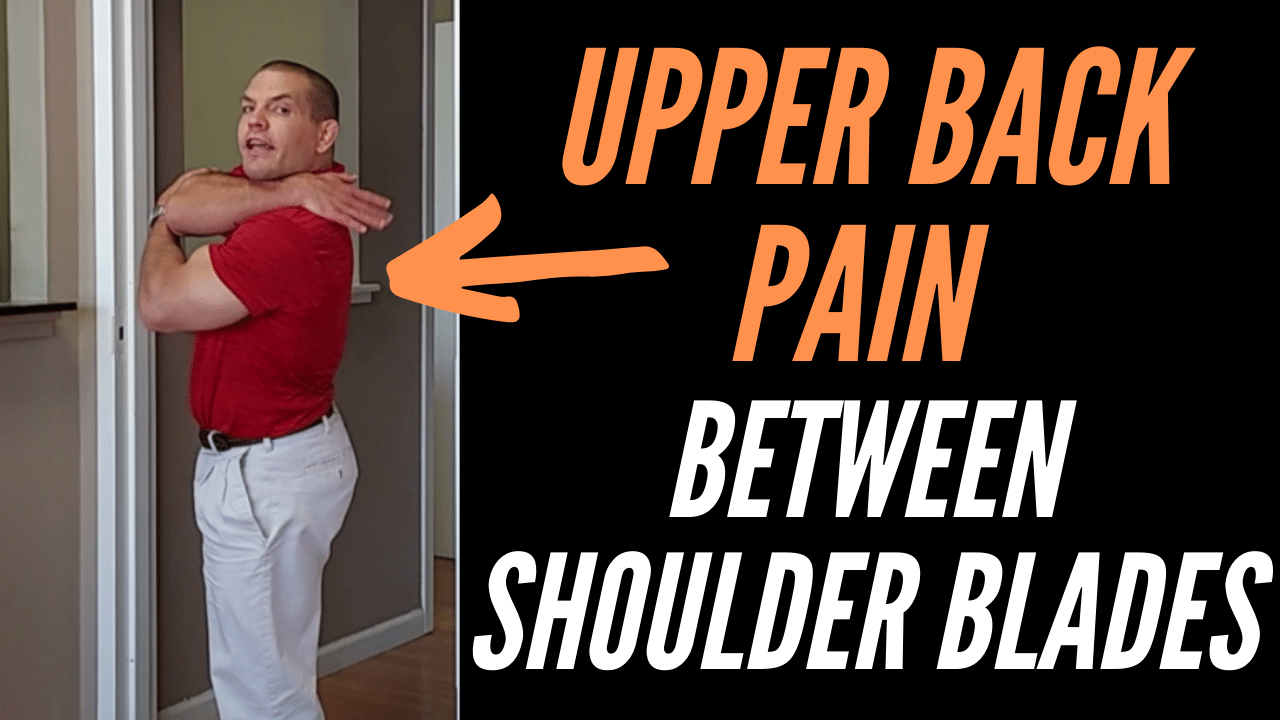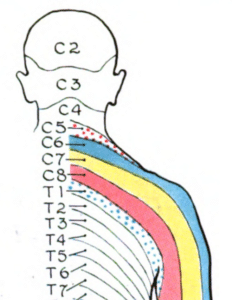Do You Get Upper Back Pain Between The Shoulder Blades?
Watch this video to learn what causes upper back pain between the shoulder blades, plus what you can do to relieve it.
What Causes Upper Back Pain Between The Shoulder Blades?
There are 2 main causes of upper back pain between the shoulder blades:

Shoulder Blades Are Too Low
The shoulder blades are suspended from your neck and upper back by muscles. Normally your shoulder blades hang between the second and seventh thoracic vertebrae (T2 to T7).
If one shoulder blade (or both) is hanging too low, it can a variety of different issues that cause pain in the shoulder blade.
Nerves That Refer Pain Into The Shoulder Blade
When your shoulder is too low, it can cause compression of the joints and nerves in the lower part of the neck. Pinched nerves in the neck can cause referred pain into the upper back and shoulder blades.
Pain from a pinched nerve in the neck is often felt as a sharp, stabbing pain in the shoulder blade or even radiating into the arm.
Muscular Pain In The Shoulder Blade
When your shoulder blades hang too low, it pulls tension on your levator scapula muscles. Trigger points in the levator scapula can also cause pain in the upper back and shoulder blade.
Additionally, when your shoulder blades hang to low, they pull tension on the rhomboid muscles which are located between the shoulder blade and the spine.
This can also cause upper back pain between the shoulder blades. You may even feel a muscle knot in your shoulder blade.
Upper Back Is Too Straight
Many people are taught to sit up straight with "good posture". This is good to a point.
However, many people take this too far. If sitting up tall is good, then sitting up taller must be better, right?
Wrong.
For most things in life there is a happy medium, and posture is no exception. Your spine is supposed to have and S-shaped curve, and the upper back is supposed to be a little rounded.
When you sit up with your upper back too straight ("military posture") it can pinch nerves in the thoracic spine, which causes referred pain around the ribcage (See T1-T7 below).
Much like a pinched nerve in the neck, a pinched nerve in the thoracic spine can also cause a sharp, stabbing pain in the upper back pain between the shoulder blades.
Sitting with too straight of posture can also cause pain or "heartburn" that isn't related to eating. Note: If the "heartburn" is new, make sure to rule out a heart attack first.
Serious Causes of Upper Back Pain Between The Shoulder Blades
As noted above, there are a few serious things that can cause shoulder blade pain. These are less common causes of shoulder blade pain, but it would be remiss to not at least mention these.
More serious causes of shoulder blade pain include:
- Heart attack - although a less common presentation, some people (especially women) may feel a heart attack in their left shoulder or shoulder blade.
- Lung problems - pleurisy, pneumonia, or even lung cancer can cause shoulder blade pain. Most commonly difficulty breathing and/or a cough would accompany this type of pain.
- Liver / gallbladder problems - the liver and gallbladder can refer pain to the right shoulder or shoulder blade, sometimes referred to as Kehr's sign. Jaundice (yellowing of the skin) and/or digestive problems may accompany this type of problem.
These are much less likely causes of shoulder blade pain that the muscle and nerve problems presented above.
In general, if posture or movement affects your shoulder blade pain, you can be pretty sure it's from a nerve, muscular, or skeletal causes.
How To Relieve Upper Back Pain Between The Shoulder Blades
- Get good arm support. Supporting your arms on armrests when sitting helps prevent your shoulder blades from pulling down on your neck and upper back muscles. If you're standing, put your hands in your pockets, hands on your hips, thumbs in your belt loops, or cross your arms so they support each other. Basically anything you can do to offload the weight of the arms.
- Slouch (a little bit). Your upper back is supposed to be a little bit rounded. You don't want to be overly slouched, but sitting up perfectly straight isn't good either. Trying to sit up too straight is a common cause of upper back pain between the shoulder blades.
For more information on postures to relieve neck, shoulder and upper back pain read these posts:
Relieve Neck Pain When Sitting
Can Bad Posture Cause Shoulder Pain?
Stretches For Upper Back Pain In Between The Shoulder Blades
Wall Slide Exercise For Upper Back Pain

Sitting Forward Reaching With Rounded Upper Back
Sit with your hands clasped together. Reach forward and allow your upper back to round while wrapping the shoulder blades around your trunk. This helps stretch the upper back muscles between the spine and the shoulder blades (the rhomboids).
Common Questions About Stretches For Upper Back Pain Between The Shoulder Blades
Q: How long should I hold the stretch?
A: It doesn't matter.
Q: How many repetitions (reps) should I do?
A: It doesn't matter. Make your total stretch time 1-2 minutes.
Q: How often should I do these stretches?
A: Regularly, but don't get caught up in the details. Anywhere from once every few hours (if you work a desk job and have upper back pain) to a few times per week (if you move regularly and are just doing it for prevention / wellness).
Q: Why can't you give more details about stretching?
A: Because it REALLY doesn't matter. Stretches are not the big thing that's going to fix your upper back pain. They're a helpful addition, but stretches are not going to make or break your success.
Focus more on the tips mentioned above in the video, change positions regularly, get regularly physical activity, and manage your stress.
These are the things that will get your upper back and shoulder blade pain better and keep it better.
Definitely don't stress over the details of your stretches.
At More 4 Life, we like to keep things as simple as possible. Often the simplest solution is the best solution.








